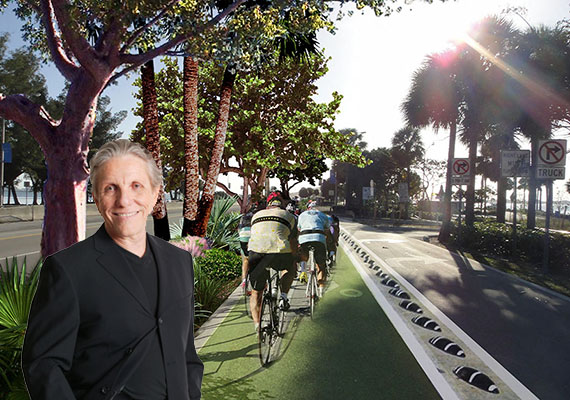Trending
Can Miami ever become as bike-friendly as Copenhagen?

In Copenhagen, Denmark, bicycles are the preferred method of transportation, not cars. Fifty-six percent of the people use bicycles to commute to work. About 70 percent ride bikes regularly.
It isn’t because Copenhagen is a municipality of tree-hugging lefty health nuts, assured Mikael Colville-Andersen, CEO and founder of Copenhagenize. It’s simply because riding a bike is the simplest way to get around Copenhagen, a municipality that has narrowed its streets for cars in order to create three-lane cycle tracks. The reason: it’s cheaper and more efficient to create infrastructure for bicycles instead of cars. A car-dedicated street can only move 1,300 people an hour, Colville-Andersen said, but a cycle track can move 5,500 people in an hour. That’s why many crowded cities around the world are looking at making their urban environments more bicycle-friendly.
“The fact is the automobile no longer has a space in the big cities of our time,” said Colville-Andersen, paraphrasing Bertrand Delanoë, the mayor of Paris from 2001 to 2014, who implemented cycling tracks in Paris.
But can Greater Miami ever become a bike-friendly city similar to Copenhagen? That was the topic of a discussion hosted by the Knight Foundation Thursday evening, held at Miami Dade College’s Wolfson Campus. The panel, moderated by the Knight Foundation’s Matt Haggman, included Colville-Andersen, Florida Department of Transportation District Six Secretary James Wolfe, Miami-Dade Metropolitan Planning Organization Executive Director Aileen Bouclé, and Bernard Zyscovich, managing principal of Zyscovich Architects who is designing Plan Z, a proposed highway/linear park system for bicycles and pedestrians along Rickenbacker Causeway that will connect Miami’s mainland to Virginia Key and Key Biscayne.
Plan Z, which will be officially unveiled on Friday at the Coral Gables Museum, was forged in response to four bicyclists who were killed along the Rickenbacker Causeway within five years, Zyscovich said. And while Zyscovich is sure that Miami can become more of a bicycle-friendly city, he admitted there is a long road ahead. “Florida’s fatality rate is three times the national average for bicycles,” Zyscovich said.
When it comes to transportation infrastructure, Wolfe of FDOT said cars were given the highest priority. That’s because 95 percent of Miami-Dade County residents use a car to commute to work while just 3 percent use transit and 2 percent either ride or walk to their jobs.
To accommodate that demand, about 1 percent of new roads have been added every year in response to a 3 percent annual growth in the county’s population, Wolfe told The Real Deal after the panel discussion. But now traffic engineers are running out of room to build new highways or widen roads to accommodate the additional vehicular traffic that often comes with new condominiums, apartments, and houses. “We cannot continue,” Wolfe said, adding that somehow the region has to “improve” the percentage of people who use other methods of transit, besides cars, to get around.
At the same time, Wolfe added, many people resist widening bike paths or creating dedicated bus lanes if it means removing parking spaces or vehicular traffic lanes. “A lot of merchants want parking on both sides of the street,” Wolfe said.
The MPO’s Bouclé said the region must figure out a way to “share the road” with bicyclists and cars alike. “Declaring war on the car is not going to advance the conversation in any way,” she said.
Bouclé said the county is also adding bicycle facilities to buses and trains, enabling more people in the suburbs to travel in and out of the urban core safely and efficiently without cars.
Trust is also a huge factor, Bouclé argued. In Copenhagen, people are so secure that they often leave their babies in carriages unattended, said the MPO director, who recently visited the Danish city with James Wolfe. Bicyclists are also more secure in knowing that they won’t be hit by a car, she added.
That’s because there are physical barriers that prevent cars from coasting into cycling zones in Copenhagen and other bicycle-friendly cities, Colville-Andersen said. Whereas in some parts of the United States, there are only narrow bike paths situated between parked cars and vehicular traffic. If he seriously suggested such a transit method in Copenhagen, Colville-Andersen asserted, he would be fired.
Zyscovich said he forged Plan Z as a “defensive gesture” for bicyclists who risk their lives traveling along the Rickenbacker Causeway. “We in Miami don’t have the confidence to ride in our urban core….,” he said.”We need to take those who are already riding and make it safer and make it more viable to use as a catalyst.”
In Plan Z, Zyscovich strived to create a system that added 20 acres of park space in Virginia Key and secure bike path highways without removing vehicular lanes. “This isn’t a war on cars. I don’t think advocacy is necessarily a single purpose concept,” Zyscovich said.
Instead, Zyscovich advocated a system where people can drive cars, ride bikes, take buses, or simply walk without being frustrated.
“We need to kind of calm down as a community and begin to [ask] ourselves, ‘What would be the best way to move the most people in the most comfortable way possible?” Zyscovich said.




